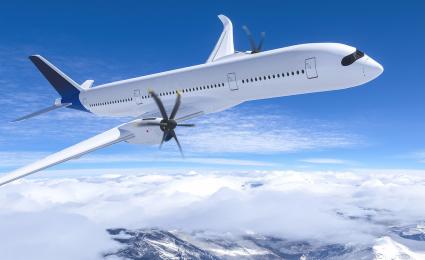A path-breaking approach to bring down aviation's total climate impact.


Navigating the future of aviation sustainability
Reflections from the Farnborough International Airshow 2024
In July 2024, we were delighted to host a breakfast event at the Farnborough International Airshow, where we explored key themes shaping the future of aviation sustainability. The discussions highlighted four pivotal areas: Sustainable Aviation Fuel (SAF), hydrogen-powered aircraft, supply chain decarbonization, and the evolving role of board governance in driving long-term sustainability. These themes are critical in achieving the ambitious climate goals of the industry and offer insights into how aviation can meet the challenges ahead.
_image_caption_none.jpg)
Sustainable Aviation Fuel: The Cornerstone of Emissions Reduction in large scale aviation
Sustainable Aviation Fuel (SAF) emerged as a central theme in the conversation. SAF is recognized as the most viable solution for reducing aviation emissions in the near term, particularly for long-haul flights, where alternatives remain limited. The International Civil Aviation Organization (ICAO) has set a target of 5% SAF usage by 2030, while more than 60 airlines have pledged to exceed 10%. Achieving these goals will require significant policy support and investment in SAF production facilities.

Currently, the European Union leads the way with mandate-driven policies, and the UK is expected to follow suit with legislation providing revenue certainty. In contrast, the United States is taking an incentive-based approach. However, despite this momentum, attracting investors to SAF projects remains a challenge, given the risks associated with building production plants. The defense sector could be a key enabler, leveraging its platforms and infrastructure to help scale SAF technology. A prime example is the Royal Air Force's collaboration on the first 100% SAF flight with an A330 Voyager, illustrating the potential of cross-industry cooperation to accelerate innovation.
"We believe that SAF is the only real opportunity to reduce our emissions in the next 10 years, and also the only viable solution for long-haul travel which makes up 70% of aviation's emissions… At the same time, robust policy support is absolutely critical [to achieve the targets]."
-Jonathon Counsell, Group Head of Sustainability at International Airlines Group (IAG)
"The armed forces can play a part in advancing SAF by using some of our platforms, infrastructure, and flight test regime to move the technology forward. The first 100% SAF flight that the RAF did in partnership with Airbus, BP and Rolls-Royce on a A330 Voyager is a great example of everybody coming together to play a part… but we also recognize that a lot of our energy transition is going to be done on the back of what the commercial sector achieves."
-Air Chief Marshal Sir Mike Wigston KCB CBE, former head of the Royal Air Force (RAF)
Hydrogen Aircraft: A Future of Possibilities
While SAF dominates the near-term landscape, hydrogen is another emerging player in the quest for decarbonization. Hydrogen’s role is still developing, with its current application more suitable for smaller aircraft due to its volumetric density. Hydrogen’s potential for long-haul flights remains distant, but green hydrogen’s role in the production of synthetic fuels could be transformative.
Many companies have incorporated hydrogen into their long-term roadmaps, with some aiming for 5-10% of their fleets being hydrogen-powered by 2050. However, significant scaling is unlikely before then. While hydrogen may not bring about immediate changes in aviation, its role in the broader energy transition is certainly significant.
"Hydrogen definitely has a role to play as it reaches maturity, with many partnerships going on. In reality, maybe for smaller applications the path would be quicker as volumetric density will be less of a challenge. For long-haul, it would be a long time, if at all, that it would be effective. For synthetic fuel SAF, hydrogen is also an important feedstock so the ability to produce green hydrogen is a key part for the whole ecosystem… I think hydrogen will have a role but not in the ways we currently expect"
-Dave Gordon, SVP UK, Europe, Asia & Africa at Rolls-Royce
Decarbonizing the Supply Chain: A Collaborative Effort
The decarbonization of the aviation supply chain is another pressing priority. The pandemic has exposed the vulnerabilities of global supply chains, reinforcing the need for leadership from OEMs, governments and policymakers to guide the sector toward more sustainable practices. Smart capital investments and clear prioritization will be essential in achieving these goals.
Increasingly, companies are embedding decarbonization into their contractual agreements, proving that supply chain sustainability and operational efficiency can go hand-in-hand. The shift toward sustainable supply chains is not just about meeting environmental targets but ensuring long-term operational resilience. As the industry strives to recover from COVID-19 disruptions, this balanced approach will be critical in driving progress.
"Customers are increasingly asking for solutions to decarbonize their part of the supply chain. There's quite a lot of demand especially from the logistics side. You see big companies and their very ambitious decarbonization targets. "
-Richard Broekman, Chief Commercial Officer and Head of Sustainability at Atlas Air Worldwide
Board Governance: Steering Sustainability from the Top
Finally, effective board governance plays a crucial role in driving long-term sustainability within the aviation sector. Boards must adopt a holistic view that extends beyond traditional Environmental, Social, and Governance (ESG) metrics. Sustainability is no longer a unique selling point but a fundamental expectation from all stakeholders. As such, the alignment of priorities across the entire supply chain is essential.

Boards are tasked with navigating the complexities of sustainability, balancing the need for significant financial investment with the long-term benefits of responsible business practices. Their leadership is crucial in setting the tone for the organization, ensuring that sustainability is embedded into every aspect of the business. The defense sector, in particular, must continue to lead by example, demonstrating how operational resilience and environmental responsibility can coexist.
"The board has a responsibility to ensure the long-term sustainability of an organization so it's really a much wider perspective… As a director, it is very important to be doing the right thing for the organization and for all our stakeholders as a whole… Why? Because shareholders and investors vote with their money, customers vote with their purchase orders and employees vote with their feet. So if we aren't seen as a responsible organization acting in this capacity, then we don't have the right to play in this industry."
-Anna Keeling, Non-executive Director at Aernnova
Conclusion: A Unified Approach to Sustainable Aviation
The conversations at the Farnborough International Airshow highlighted the interconnected nature of aviation’s sustainability journey. Whether it’s the scaling of SAF, the potential of hydrogen, the decarbonization of supply chains, or the role of board governance, collaboration across industries and stakeholders is key. By aligning priorities and fostering innovation, the aviation sector can rise to the challenge of decarbonization, ensuring a more sustainable future for generations to come. As we look ahead, the continued commitment from all players in the industry will be critical to meeting both near-term and long-term sustainability goals.
We would like to thank Siyi Hoa and Miguel Lopez for co-authoring this article.






_person_320.png)


